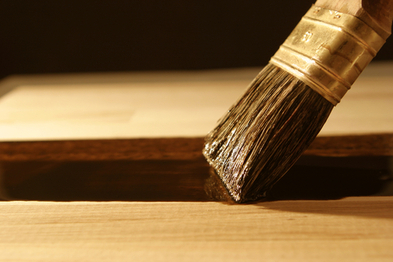If you want to keep your wood looking like wood you can use preservers, dye, oil, wax, hard wax oil, stain or varnish to achieve a more natural finish. Whatever finish you choose it is likely to darken the colour of the wood to some degree and it is well worth testing on an inconspicuous area first. The original colour of your wood will have an impact on the end result and it is worth bearing this in mind if you are choosing a colour. Ideal products for exterior wood include UV filters (sun block for wood!) but separate UV primers are also available to increase the longevity of coatings and protect the underlying wood from greying.
Before choosing a new finish, try to identify exactly what type of wood you are working with and what finish it may already have been coated with. Resinous hardwoods are likely to require different finishes to softwoods. If you are happy with the type of finish you already have it is often simplest to stick with it. If not, it may be necessary to remove old coatings before re-coating which could prove troublesome.
So what do these finishes do and when should you use them?
Preservers should be applied liberally to soak into all new bare or well weathered exterior wood to protect against rot and insect damage. Clear preservers are designed for use under other finishes and are more suited to smooth planed timber such as window frames. Coloured preservers are a finish in their own right and are suitable for rough sawn timber such as fences and sheds.
Dyes are simply that, a dye. They sink into the surface of the wood and change the colour but offer no protection to the surface, so a clear finish will be required on top. A major benefit of using a dye first, is that if the clear finish is chipped, the colour of the wood will remain the same, unlike a coloured finish that could result in a fairly obvious mark. Generally you will only be able to make the wood darker unless you use wood bleach to lighten it first.
Oils sink into the surface and nourish the wood. Traditional oils need between three to five coats and will probably need to be re-coated at least once a year to remain effective. Some new products are now available on the market needing fewer coats and lasting for several years. The most common types of oil include Danish, teak, boiled linseed, raw linseed and tung oil. Depending on what type of wood you are oiling and whether it is interior or exterior will determine with which to use.
Waxes sit on the surface of the wood and can be clear or coloured. They are available in solid and liquid varieties (including speciality floor wax) and are suitable for interior use. Liquid wax is generally used on larger areas. The finish is silky and tactile however it will attract grime over time and will need to be re-finished at intervals.
Hard Wax Oil is a relatively new addition to the market, is a wax and oil blend and can be used on all internal wood including floors. It is a very hardwearing finish that penetrates and sits on the surface, is applied very thinly and needs fewer coats than traditional oils. It will last for a good number of years before requiring additional coats and is available in clear and coloured varieties. Any damaged areas are easy to renovate by sanding back and re-applying the product.
Woodstain sinks into the surface of the wood. Most can be used on both interior and exterior wood and lasts for a number of years. They are coloured and are either translucent which allows the grain to show through or opaque giving the appearance of a painted finish. Woodstain is easy to maintain as often you only need to lightly sand down and apply another coat when water no longer beads on the surface.
Varnish sits on the surface of the wood and is available for interior and exterior (including speciality floor varnish). Water and solvent-based formulations are on the market in matt, satin and gloss as well as wax finishes. While initially forming a good barrier it eventually will peel, crack or flake and will need to be completely rubbed down before re-applying.
Before choosing a new finish, try to identify exactly what type of wood you are working with and what finish it may already have been coated with. Resinous hardwoods are likely to require different finishes to softwoods. If you are happy with the type of finish you already have it is often simplest to stick with it. If not, it may be necessary to remove old coatings before re-coating which could prove troublesome.
So what do these finishes do and when should you use them?
Preservers should be applied liberally to soak into all new bare or well weathered exterior wood to protect against rot and insect damage. Clear preservers are designed for use under other finishes and are more suited to smooth planed timber such as window frames. Coloured preservers are a finish in their own right and are suitable for rough sawn timber such as fences and sheds.
Dyes are simply that, a dye. They sink into the surface of the wood and change the colour but offer no protection to the surface, so a clear finish will be required on top. A major benefit of using a dye first, is that if the clear finish is chipped, the colour of the wood will remain the same, unlike a coloured finish that could result in a fairly obvious mark. Generally you will only be able to make the wood darker unless you use wood bleach to lighten it first.
Oils sink into the surface and nourish the wood. Traditional oils need between three to five coats and will probably need to be re-coated at least once a year to remain effective. Some new products are now available on the market needing fewer coats and lasting for several years. The most common types of oil include Danish, teak, boiled linseed, raw linseed and tung oil. Depending on what type of wood you are oiling and whether it is interior or exterior will determine with which to use.
Waxes sit on the surface of the wood and can be clear or coloured. They are available in solid and liquid varieties (including speciality floor wax) and are suitable for interior use. Liquid wax is generally used on larger areas. The finish is silky and tactile however it will attract grime over time and will need to be re-finished at intervals.
Hard Wax Oil is a relatively new addition to the market, is a wax and oil blend and can be used on all internal wood including floors. It is a very hardwearing finish that penetrates and sits on the surface, is applied very thinly and needs fewer coats than traditional oils. It will last for a good number of years before requiring additional coats and is available in clear and coloured varieties. Any damaged areas are easy to renovate by sanding back and re-applying the product.
Woodstain sinks into the surface of the wood. Most can be used on both interior and exterior wood and lasts for a number of years. They are coloured and are either translucent which allows the grain to show through or opaque giving the appearance of a painted finish. Woodstain is easy to maintain as often you only need to lightly sand down and apply another coat when water no longer beads on the surface.
Varnish sits on the surface of the wood and is available for interior and exterior (including speciality floor varnish). Water and solvent-based formulations are on the market in matt, satin and gloss as well as wax finishes. While initially forming a good barrier it eventually will peel, crack or flake and will need to be completely rubbed down before re-applying.


 RSS Feed
RSS Feed
